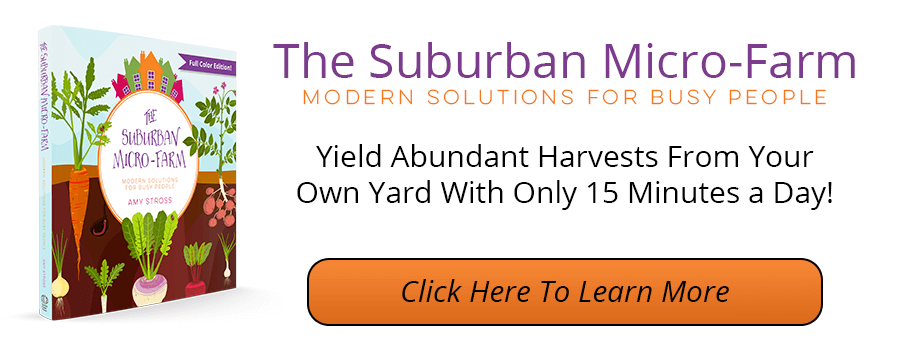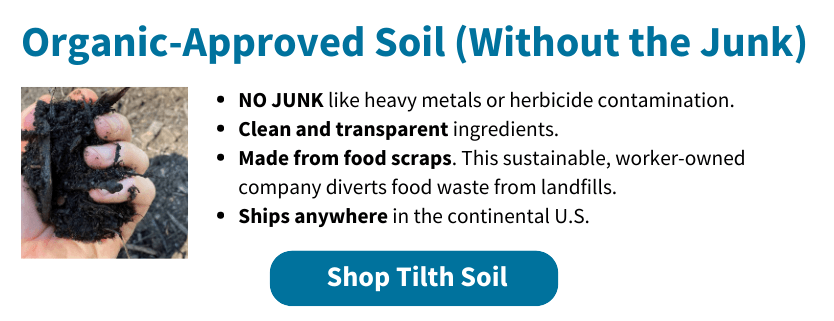How To Improve Your Soil For Gardening

Good quality soil is essential for a healthy and abundant garden. Here are seven ways to transform ailing, lifeless soil into rich, black gold.
This page may contain affiliate links. Please read my disclosure for more info.

Does your garden consist of lifeless or hardpan soil? While there are many ways to improve soil quality for the purpose of growing food, in this article I'll share the methods that have been the most successful for me. Believe me, I've tried a lot of things!
When my first house was built in the 1950s, the developers scraped the topsoil from the yard, sowing grass directly into hard clay. Later (before I lived there), a second owner filled in the in-ground swimming pool with fill dirt (which, by definition, contains zero organic matter).
I discovered this when I started digging in the backyard to start my gardens, finding giant chunks of blue-painted concrete mixed with lifeless dirt.
It became my mission to transform my yard into a rich, abundant garden. I figured if I could do it, then others could do it too!
Improving Soil Tilth
Tilth refers to the physical condition of soil—how suitable it is for planting crops. Healthy soil with good tilth includes lots of organic matter. It is well-aerated and well-drained, yet retains enough moisture to feel like a wrung-out sponge.
To revive lifeless soil, aim to improve its tilth.
7 Ways to Improve Soil Quality
The following are the ways in which I improved my lifeless soil with the most success.
1: Create Permanent Garden Beds and Pathways
One rule that I learned early in my garden training is to never walk in garden beds. Stepping on garden soil compacts it, which destroys tilth as well as beneficial soil organisms and their habitat.
Establish permanent beds and walkways so that the beds are clearly defined.
Keep them narrow enough that you can reach all areas without stepping inside to keep foot traffic out. Beds created in this way can improve each year rather than starting each season in a compacted state from last year's walkways.
In addition to keeping soil in the garden beds loose, permanent beds also save time and money.
Rather than applying costly amendments over a broad area, you need only apply them to permanent bed areas, skipping the pathways. Irrigation installation is easier, too, since the beds are permanent fixtures.
Permanent pathways of white clover, microclover, or wood chips attract beneficial insects and fertilize the garden.
2: Choose NOT To Till

Tilling is a mechanical method for quickly loosening and aerating soil in preparation for planting.
Although it may be useful on large farms where managing soil by hand would be impractical, a tiller is simply a quick fix in small gardens and on micro-farms, where it can have detrimental effects on soil in the long run.
In some instances, tilling can encourage the soil to blow away in the wind or wash away in the rain. Read about How to Prevent Soil Erosion in your garden. It can also destroy beneficial soil organisms.
Fortunately, growing crops on a small backyard scale doesn't require tilling to produce loose soil for planting.
A digging fork or a broadfork are useful tools in the no-till garden because they loosen the soil without destroying microorganisms. A digging fork gently aerates and loosens the top few inches of soil before planting.
Get more tips in my article Transitioning to a No-Till Garden.
3: Create a New Garden with Sheet Mulching
Sheet mulching is a no-till method for starting a new garden or reigning in a garden that's been overtaken by weeds. It consists of smothering existing vegetation with a layer of cardboard, and topping it with a new planting medium.
The decomposing cardboard and plant residue attracts worms and other soil organisms. The organic matter on top of the cardboard can consist of compost-approved food scraps, grass clippings, or manure (be aware of poisoned manure), that is topped with straw or shredded leaves or office paper.
The final top layer consists of compost soil (homemade compost or store-bought compost soil), 6-18 inches in depth. As it all decomposes, the contents of the sheet mulch will shrink in size.
Allow sheet-mulched areas to sit for at least two weeks before planting, and ideally for three months, to allow it to decompose into a rich planting medium.

Here, I'm sheet mulching an area of lawn by adding a layer of horse manure over cardboard.

After applying horse manure and shredded leaves, I topped this new circle garden with a layer of compost soil for planting, and a wood-chip pathway.
4: Add Organic Matter
We often start out with soil that is not ideal for growing food. But we're anxious to get growing, so we go ahead anyway. Now we're asking our soil to produce nutrient-dense food from nutrient-deficient soil. This can lead to lackluster harvests or pest and disease problems.
Amending soil in the fall is important even if you start with great soil, simply because of the nutrients you've harvested from it throughout the season.
You see, there is reciprocity between you and the soil in organic gardening; a give and take. Fall and winter is a great time to replenish soil and let it rest if necessary.
Add organic matter in the fall to start every spring garden on a good note.
Read more:
- Building a Compost Bin (5 Ways)
- How to Improve Clay Soil
- Worm Compost (make your own or buy worm castings)

Food scraps transformed into rich worm castings.
Would you like to learn more about improving the health of your soil, reducing maintenance, and increasing yield?
You'll find loads of information just like this in my award-winning book, The Suburban Micro-Farm .

5: Mulch for Big Benefits
Mulching encourages healthy soil tilth by retaining moisture and nutrients. It also saves time by reducing the need for weeding, watering, and fertilizing.
How you mulch your garden beds depends on your climate.
For example, heavier mulches are beneficial in hot, dry climates where moisture evaporation is high. In contrast, lighter mulches are more appropriate in cool, rainy climates where soil benefits from the warmth of the sun, but still needs protection against erosion.
For most gardeners, a heavy mulch in the off season provides protection beneficial soil organisms against the elements and reduces soil erosion from heavy rains.
After a pest outbreak, however, discard affected plant material and do not apply mulch over the winter so as not to provide protection to overwintering pests.
There are many ways to mulch and many types of materials to use. Learn more in my article Mulching in the Permaculture Garden.

Grass clippings topped with shredded leaves makes a balanced mulch that reduces weeds and retains moisture.

6: Plant Cover Crops
Cover crops are an excellent addition to your soil improvement program. They can provide organic matter and nutrients, improve drainage and aeration, attract beneficial soil organisms, and act as an overwintering mulch.
While cover crops can be grown in rotation with other crops at any time throughout the year, they are most popularly sown in the late summer or early fall to grow over the winter.
Many are killed by the winter cold to make spring planting easy, while others are turned under before planting. Use a digging fork (or chickens!) to turn cover crops under about three weeks before planting in the spring.
Here are some cover crops that have worked well for me:
- Buckwheat
- Cowpeas
- Daikon Radish
Here are some clay-busting plants that fight compaction.
Read more about cover crops:
- Choosing the Best Cover Crops for your Organic No-Till Vegetable System
- Cover Crops: Feeding the Soil that Feeds Me
- Homegrown Humus: Cover Crops in a No-till Garden
7: Grow Chop-and-Drop Nutrient Accumulators
Nutrient accumulators are plant species that are often integrated into permaculture gardens. The roots of 'accumulators' are said to collect specific nutrients from the soil.
These potentially nutrient-rich plants can be chopped back several times throughout the year in order to use the cuttings as a mulch. This may save money by reducing the number of soil amendments you need to purchase. Growing them may also improve biodiversity.
Although there hasn't been a lot of research conducted on nutrient accumulators, comfrey is the most often-cited plant. This study suggests using comfrey as an organic, DIY fertilizer spray. Learn more about using comfrey to fertilize your garden.
Here are some herbaceous plants to 'chop and drop':
- Comfrey: Learn how to grow comfrey or buy comfrey root for planting
- Weeds: Learn 5 weeds you want in your garden
- Yarrow: Learn 5 reasons to grow yarrow or buy yarrow seeds

Flowering comfrey attracts beneficial insects and provides nutrient-rich mulch.
There are many ways to improve soil quality, but at the heart of each method is the goal of reducing compaction, amending soil with organic matter, and taking advantage of the off-season.
What methods have you used to improve your garden soil?
READ NEXT:
- 4 Berry Bushes that Fertilize, Too!
- 7 Reasons to Grow Calendula
- Comfrey Fertilizer: Does it Really Improve Soil?
>>> Get my free 19-page Guide to Organic Soil Amendments for more ideas:
How To Improve Your Soil For Gardening
Source: https://www.tenthacrefarm.com/improve-soil-quality/
Posted by: yudeppoccanot85.blogspot.com

0 Response to "How To Improve Your Soil For Gardening"
Post a Comment